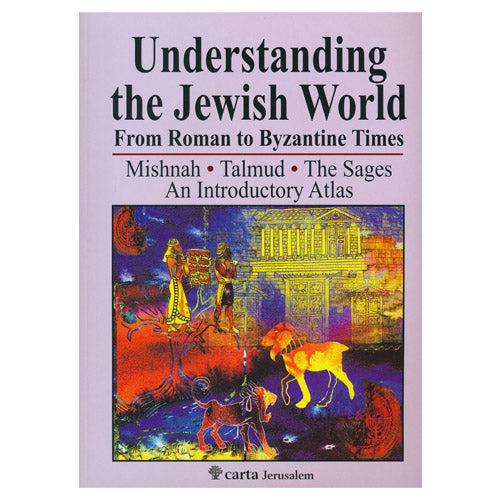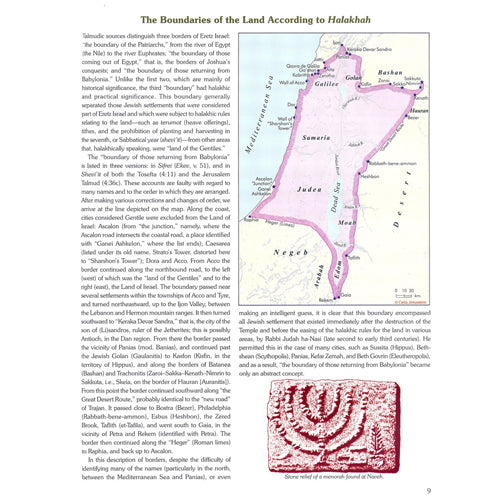Understanding The Jewish World by Carta
Understanding The Jewish World by Carta
SKU: PB402.2
Couldn't load pickup availability
This Atlas tells the intriguing story of the revival of Jewish life in the land of Israel. Having suppressed the Bar Kokhba Revolt, the Romans went further, began to eradicate Jewish settlements of Judea, and made great efforts to blur the national identity of the Jews in the land. They plowed up the Temple and on the ruins founded the Roman city Aelia Capitolina. Exiled from Jerusalem, the Sanhedrin moved from place to place, settling finally in Tiberias.
Additional Information
Additional Information
This Atlas tells the intriguing story of the revival of Jewish life in the land of Israel. Having suppressed the Bar Kokhba Revolt, the Romans went further, began to eradicate Jewish settlements of Judea, and made great efforts to blur the national identity of the Jews in the land. They plowed up the Temple and on the ruins founded the Roman city Aelia Capitolina. Exiled from Jerusalem, the Sanhedrin moved from place to place, settling finally in Tiberias.
In the mid-2nd century the Romans gave up on their attempt to eradicate the Jews, and gradually Jewish life saw a resurgence in the land that brought with it urbanization, and the revival of spiritual life. The generations of sages, Tannaim, Amoraim, elders, and rabbis who gave us the compilation of the Oral Law and literature are listed in detail, as are the newly-founded cities, migrations, and the links between the Diaspora and Eretz Israel, right up to the 5th century. The political and ecclesiastical divisions of Palestine in the Byzantine era further illustrated the physical and political backdrop to this fascinating saga. The final map details the dispersion of the Jewish people over three continents.
Significantly, the onset of the first century witnessed the birth, deeds, and martyrdom of Jesus and the acts of his apostles. The sometimes divergence from established tradition led to the emergence of Christianity, a new faith that was fast becoming the dominant religion of the western world and incidentally brought with it a new calendar - BC/AD or BCE/CE, now in its third millennium.
Written by Michael Avi-Yonah with Shmuel Safrai. This Atlas tells the intriguing story of the revival of Jewish life in the land of Israel. Having suppressed the Bar Kokhba Revolt, the Romans went further, began to eradicate Jewish settlements of Judea, and made great efforts to blur the national identity of the Jews in the land. They plowed up the Temple and on the ruins founded the Roman city Aelia Capitolina. Exiled from Jerusalem, the Sanhedrin moved from place to place, settling finally in Tiberias.
Contents:
- Introduction
- Aftermath of the Bar Kokhba Revolt
- Renewal of Jewish Settlements in Eretz Israel
- Eretz Israel in the Days of the Amoraim
- The Amoraim in Babylonia
- The Close of the Byzantine Period
Excerpt from Introduction:
"The land of Israel has been a battleground since time immemorial and the first century CE was no exception. The most disastrous event for the Jewish people was the destruction of their Holy Temple on the 9th of Av in 70 CE. That, according to tradition, was the very same day that the First Temple had been destroyed centuries earlier. The loss of the Temple was not the only traumatic event. A great many wars, campaigns, and rebellions, often followed by destruction and massacres or exile, occurred at the time, culminating in the Bar Kokhba revolt."
About the Authors: Michael Avi-Yonah (1904-74) was a Professor of Archaeology and History of Art at The Hebrew University Of Jerusalem. He wrote numerous books and papers. He planned and constructed a model of the Second Temple Jerusalem at 1:50 scale, now on display at the Israel Museum, Jerusalem. Shmuel Safrai (1919-2003), a founding member of the Jerusalem School of Synoptic Research, was an emeritus professor of Jewish History of the Mishnaic and Talmudic Period at the Hebrew University of Jerusalem. Safrai was the recipient of several literary prizes for his research and wrote over 80 articles and 12 books.
Soft Cover
40 pages
9 x11.75 in. (23 x30 cm)
Share








